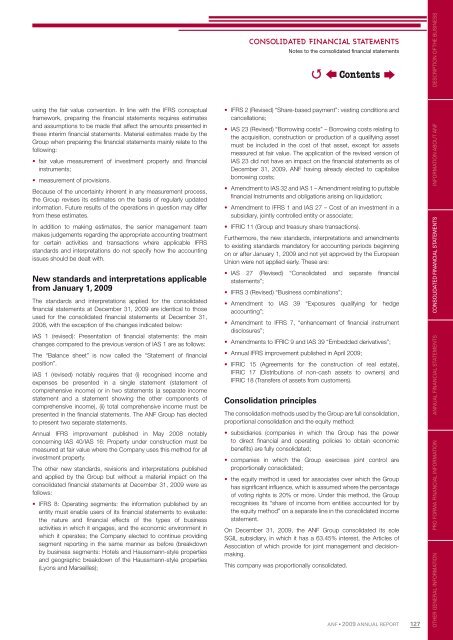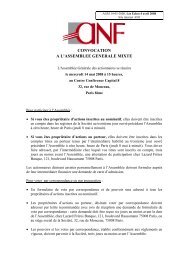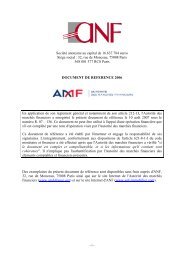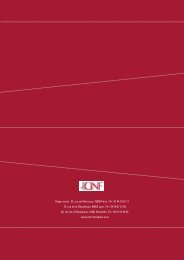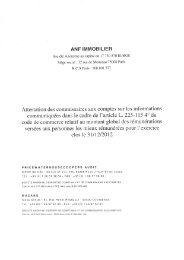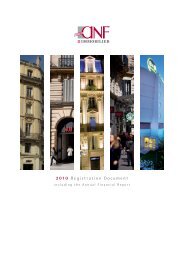Download the 2009 annual report in PDF format - ANF
Download the 2009 annual report in PDF format - ANF
Download the 2009 annual report in PDF format - ANF
You also want an ePaper? Increase the reach of your titles
YUMPU automatically turns print PDFs into web optimized ePapers that Google loves.
us<strong>in</strong>g <strong>the</strong> fair value convention. In l<strong>in</strong>e with <strong>the</strong> IFRS conceptual<br />
framework, prepar<strong>in</strong>g <strong>the</strong> fi nancial statements requires estimates<br />
and assumptions to be made that affect <strong>the</strong> amounts presented <strong>in</strong><br />
<strong>the</strong>se <strong>in</strong>terim fi nancial statements. Material estimates made by <strong>the</strong><br />
Group when prepar<strong>in</strong>g <strong>the</strong> fi nancial statements ma<strong>in</strong>ly relate to <strong>the</strong><br />
follow<strong>in</strong>g:<br />
• fair value measurement of <strong>in</strong>vestment property and fi nancial<br />
<strong>in</strong>struments;<br />
• measurement of provisions.<br />
Because of <strong>the</strong> uncerta<strong>in</strong>ty <strong>in</strong>herent <strong>in</strong> any measurement process,<br />
<strong>the</strong> Group revises its estimates on <strong>the</strong> basis of regularly updated<br />
<strong>in</strong><strong>format</strong>ion. Future results of <strong>the</strong> operations <strong>in</strong> question may differ<br />
from <strong>the</strong>se estimates.<br />
In addition to mak<strong>in</strong>g estimates, <strong>the</strong> senior management team<br />
makes judgements regard<strong>in</strong>g <strong>the</strong> appropriate account<strong>in</strong>g treatment<br />
for certa<strong>in</strong> activities and transactions where applicable IFRS<br />
standards and <strong>in</strong>terpretations do not specify how <strong>the</strong> account<strong>in</strong>g<br />
issues should be dealt with.<br />
New standards and <strong>in</strong>terpretations applicable<br />
from January 1, <strong>2009</strong><br />
The standards and <strong>in</strong>terpretations applied for <strong>the</strong> consolidated<br />
fi nancial statements at December 31, <strong>2009</strong> are identical to those<br />
used for <strong>the</strong> consolidated fi nancial statements at December 31,<br />
2008, with <strong>the</strong> exception of <strong>the</strong> changes <strong>in</strong>dicated below:<br />
IAS 1 (revised): Presentation of fi nancial statements: <strong>the</strong> ma<strong>in</strong><br />
changes compared to <strong>the</strong> previous version of IAS 1 are as follows:<br />
The “Balance sheet” is now called <strong>the</strong> “Statement of fi nancial<br />
position”.<br />
IAS 1 (revised) notably requires that (i) recognised <strong>in</strong>come and<br />
expenses be presented <strong>in</strong> a s<strong>in</strong>gle statement (statement of<br />
comprehensive <strong>in</strong>come) or <strong>in</strong> two statements (a separate <strong>in</strong>come<br />
statement and a statement show<strong>in</strong>g <strong>the</strong> o<strong>the</strong>r components of<br />
comprehensive <strong>in</strong>come), (ii) total comprehensive <strong>in</strong>come must be<br />
presented <strong>in</strong> <strong>the</strong> fi nancial statements. The <strong>ANF</strong> Group has elected<br />
to present two separate statements.<br />
Annual IFRS improvement published <strong>in</strong> May 2008 notably<br />
concern<strong>in</strong>g IAS 40/IAS 16: Property under construction must be<br />
measured at fair value where <strong>the</strong> Company uses this method for all<br />
<strong>in</strong>vestment property.<br />
The o<strong>the</strong>r new standards, revisions and <strong>in</strong>terpretations published<br />
and applied by <strong>the</strong> Group but without a material impact on <strong>the</strong><br />
consolidated fi nancial statements at December 31, <strong>2009</strong> were as<br />
follows:<br />
• IFRS 8: Operat<strong>in</strong>g segments: <strong>the</strong> <strong>in</strong><strong>format</strong>ion published by an<br />
entity must enable users of its fi nancial statements to evaluate:<br />
<strong>the</strong> nature and fi nancial effects of <strong>the</strong> types of bus<strong>in</strong>ess<br />
activities <strong>in</strong> which it engages, and <strong>the</strong> economic environment <strong>in</strong><br />
which it operates; <strong>the</strong> Company elected to cont<strong>in</strong>ue provid<strong>in</strong>g<br />
segment <strong>report</strong><strong>in</strong>g <strong>in</strong> <strong>the</strong> same manner as before (breakdown<br />
by bus<strong>in</strong>ess segments: Hotels and Haussmann-style properties<br />
and geographic breakdown of <strong>the</strong> Haussmann-style properties<br />
(Lyons and Marseilles);<br />
CONSOLIDATED FINANCIAL STATEMENTS<br />
Notes to <strong>the</strong> consolidated fi nancial statements<br />
�<br />
• IFRS 2 (Revised) “Share-based payment”: vest<strong>in</strong>g conditions and<br />
cancellations;<br />
• IAS 23 (Revised) “Borrow<strong>in</strong>g costs” – Borrow<strong>in</strong>g costs relat<strong>in</strong>g to<br />
<strong>the</strong> acquisition, construction or production of a qualify<strong>in</strong>g asset<br />
must be <strong>in</strong>cluded <strong>in</strong> <strong>the</strong> cost of that asset, except for assets<br />
measured at fair value. The application of <strong>the</strong> revised version of<br />
IAS 23 did not have an impact on <strong>the</strong> fi nancial statements as of<br />
December 31, <strong>2009</strong>, <strong>ANF</strong> hav<strong>in</strong>g already elected to capitalise<br />
borrow<strong>in</strong>g costs;<br />
• Amendment to IAS 32 and IAS 1 – Amendment relat<strong>in</strong>g to puttable<br />
fi nancial Instruments and obligations aris<strong>in</strong>g on liquidation;<br />
• Amendment to IFRS 1 and IAS 27 – Cost of an <strong>in</strong>vestment <strong>in</strong> a<br />
subsidiary, jo<strong>in</strong>tly controlled entity or associate;<br />
• IFRIC 11 (Group and treasury share transactions).<br />
Fur<strong>the</strong>rmore, <strong>the</strong> new standards, <strong>in</strong>terpretations and amendments<br />
to exist<strong>in</strong>g standards mandatory for account<strong>in</strong>g periods beg<strong>in</strong>n<strong>in</strong>g<br />
on or after January 1, <strong>2009</strong> and not yet approved by <strong>the</strong> European<br />
Union were not applied early. These are:<br />
• IAS 27 (Revised) “Consolidated and separate fi nancial<br />
statements”;<br />
• IFRS 3 (Revised) “Bus<strong>in</strong>ess comb<strong>in</strong>ations”;<br />
• Amendment to IAS 39 “Exposures qualify<strong>in</strong>g for hedge<br />
account<strong>in</strong>g”;<br />
• Amendment to IFRS 7, “enhancement of fi nancial <strong>in</strong>strument<br />
disclosures”;<br />
• Amendments to IFRIC 9 and IAS 39 “Embedded derivatives”;<br />
• Annual IFRS improvement published <strong>in</strong> April <strong>2009</strong>;<br />
• IFRIC 15 (Agreements for <strong>the</strong> construction of real estate),<br />
IFRIC 17 (Distributions of non-cash assets to owners) and<br />
IFRIC 18 (Transfers of assets from customers).<br />
Consolidation pr<strong>in</strong>ciples<br />
Contents<br />
The consolidation methods used by <strong>the</strong> Group are full consolidation,<br />
proportional consolidation and <strong>the</strong> equity method:<br />
• subsidiaries (companies <strong>in</strong> which <strong>the</strong> Group has <strong>the</strong> power<br />
to direct fi nancial and operat<strong>in</strong>g policies to obta<strong>in</strong> economic<br />
benefi ts) are fully consolidated;<br />
• companies <strong>in</strong> which <strong>the</strong> Group exercises jo<strong>in</strong>t control are<br />
proportionally consolidated;<br />
• <strong>the</strong> equity method is used for associates over which <strong>the</strong> Group<br />
has signifi cant <strong>in</strong>fl uence, which is assumed where <strong>the</strong> percentage<br />
of vot<strong>in</strong>g rights is 20% or more. Under this method, <strong>the</strong> Group<br />
recognises its “share of <strong>in</strong>come from entities accounted for by<br />
<strong>the</strong> equity method” on a separate l<strong>in</strong>e <strong>in</strong> <strong>the</strong> consolidated <strong>in</strong>come<br />
statement.<br />
On December 31, <strong>2009</strong>, <strong>the</strong> <strong>ANF</strong> Group consolidated its sole<br />
SGIL subsidiary, <strong>in</strong> which it has a 63.45% <strong>in</strong>terest, <strong>the</strong> Articles of<br />
Association of which provide for jo<strong>in</strong>t management and decisionmak<strong>in</strong>g.<br />
This company was proportionally consolidated.<br />
<strong>ANF</strong> • <strong>2009</strong> ANNUAL REPORT<br />
127<br />
OTHER GENERAL GENERAL INFORMATION PRO FORMA FINANCIAL INFORMATION ANNUAL FINANCIAL STATEMENTS CONSOLIDATED FINANCIAL FINANCIAL STATEMENTS INFORMATION ABOUT <strong>ANF</strong> DESCRIPTION OF THE BUSINESS


